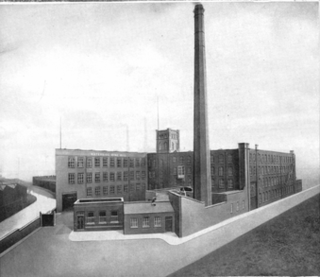Bagley & Wright was a spinning, doubling and weaving company based in Oldham, Lancashire, England. The business, which was active from 1867 until 1924, 'caught the wave' of the cotton-boom that existed following the end of the American Civil War in 1865 and experienced rapid growth in the United Kingdom and abroad.

Waterside Mill, Ashton-under-Lyne was a combined cotton spinning weaving mill in Whitelands, Ashton-under-Lyne, Greater Manchester, England. It was built as two independent factories. The weaving sheds date from 1857; the four-storey spinning mill dates from 1863. The spinning was taken over by the Lancashire Cotton Corporation in the 1930s. Production finished in 1959. Waterside Mill was converted to electricity around 1911.

James Mawdsley was an English trade unionist. Alongside Winston Churchill, he stood as a Conservative Party candidate in the double Oldham by-election of 1899. He was born in Preston, Lancashire, to cotton spinner James Mawdsley and his wife, Jane.
The Cardroom Amalgamation or Cardroom Workers' Amalgamation (CWA) was a British trade union which existed between 1886 and 1974. It represented workers in the cotton textile industry.

The Amalgamated Weavers' Association, often known as the Weavers' Amalgamation, was a trade union in the United Kingdom. Initially, it operated in competition with the North East Lancashire Amalgamated Weavers' Association in part of its area, and it was therefore nicknamed the Second Amalgamation.
Piece-rate lists were the ways of assessing a cotton operatives pay in Lancashire in the nineteenth and early twentieth centuries. They started as informal agreements made by one cotton master and their operatives then each cotton town developed their own list. Spinners merged all of these into two main lists which were used by all, while weavers used one 'unified' list.
The United Textile Factory Workers' Association (UTFWA) was a trade union federation in Great Britain. It was active from 1889 until 1975.

Fred Garfield Hague was a British trade unionist.
Edward Wagstaff Judson was an English trade unionist.

Thomas Ashton was a British trade union leader.
William Marsland was a British trade unionist.
The Oldham Provincial Card and Blowing Room and Ring Frame Operatives' Association was a trade union representing cotton industry workers in Oldham, Lancashire, in England. Long the largest union in the industry, it played a leading role in establishing a regional federation of cardroom workers.
The South East Lancashire Provincial Card and Blowing Room Operatives' Association was a trade union representing cotton industry workers in Ashton-under-Lyne and surrounding areas of Lancashire in England.

The Cotton Factory Times was a weekly British newspaper, aimed at cotton mill workers in Lancashire and Cheshire.
The Hyde and District Card, Blowing and Ring Frame Operatives' Association was a trade union representing cotton industry workers in Hyde and surrounding areas of Cheshire in England.
The Bolton and District Operative Cotton Spinners' Provincial Association (BOCSPA) was a trade union representing cotton spinners across central Lancashire, in England. It was the most important union of cotton spinners, and dominated the Spinners' Amalgamation.
The Oldham Operative Cotton Spinners' Provincial Association was a trade union representing cotton spinners across eastern Lancashire, in England. It was often the large spinners' union, and provided much of the leadership of the Spinners' Amalgamation.
Charles Schofield was a British trade unionist.
The Preston Provincial Operative Cotton Spinners' Association was a trade union representing cotton spinners in the Preston area of Lancashire, in England.
James William Whitworth was a British trade union leader and politician.







